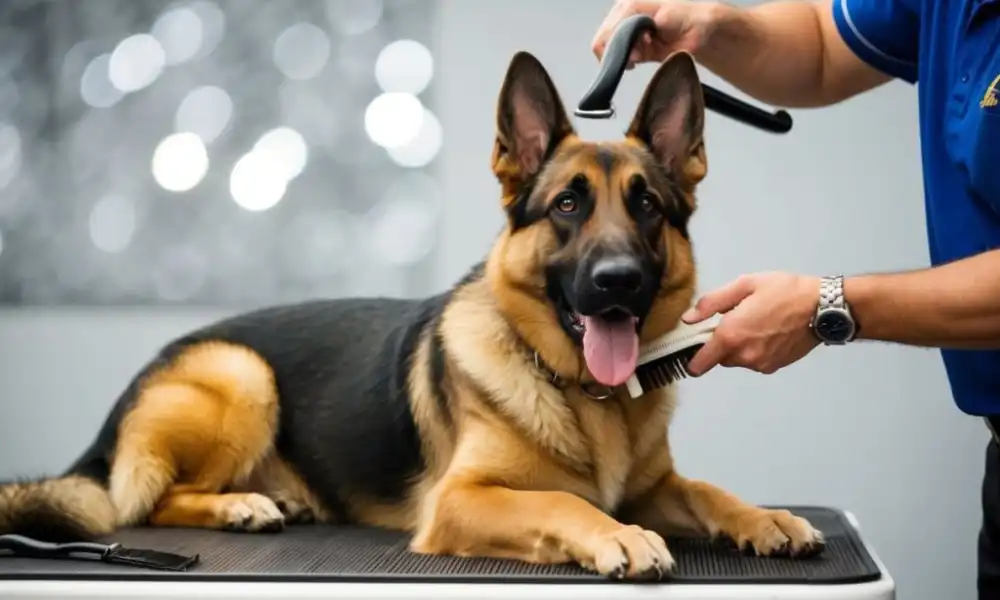GSDs are one of the most loved dog breeds across the globe, having earned their reputation for intelligence, loyalty, and the classic shedding of two layers of fur.
Caring for the coat on a German Shepherd is more complicated than on other dogs because of its specific requirements. Proper grooming GSD looks sharp and improves their comfort and health.
Here, you will find information about the fundamental needs of German Shepherd grooming, as well as some grooming pointers for the dog’s coat, nails, and ears.
Key Points
- Understanding the German Shepherd Coat
- Common Grooming Mistakes and How to Avoid Them
- Neglecting Shed Release Techniques
- Using the Wrong Tools
- Shaving the Coat
- Infrequent Nail Trimming
- Ignoring German Shepherd Ears Care
- How to Groom a German Shepherd: Expert Tips
- FAQs
- Conclusion
01. Understanding the German Shepherd Coat
The German Shepherd gets the best double-layer, functional, and aesthetically pleasing coat. The layer consists of soft, hairy fur. This protects the outer jacket from water and other natural factors in cold climates.
German Shepherds shed a lot, especially during the spring and fall seasons.
- The skin in dogs is susceptible; therefore, correct hygiene contributes to health and physical appearance.
- To correctly identify the dos and don’ts, you should learn what you should not do and how German shepherd grooming can be a bonding and caring session.
If you’re unsure about grooming techniques, ask a vet for professional advice on keeping your dog’s coat in good condition.
02. Common Grooming Mistakes and How to Avoid Them
This section will discuss what mistakes you should never repeat when grooming GSD.
The following are some listed:
01. Neglecting Shed Release Techniques
How to groom a German shepherd with shed release? This is the question from many of you. German Shepherds are prolific shedders, especially during seasonal changes.
Failing to use effective shed release methods can lead to fur buildup, tangling, and even skin issues due to trapped debris.
Solution:
- Use a de-shedding tool designed explicitly for double-coated breeds.
- A shedding blade or undercoat rake is ideal for reaching through to the undercoat and removing loose fur.
- Brush your GSD at least twice weekly and daily during heavy shedding seasons.
| Tool | Purpose | Frequency |
|---|---|---|
| Tool | Purpose | Frequency |
| Undercoat Rake | Removes loose undercoat hair | Weekly or daily in shedding seasons |
| Slicker Brush | Smooths and prevents matting | 2-3 times per week |
| De-Shedding Tool | Reduces loose fur during shedding | Weekly or as needed |
02. Using the Right Grooming Tools

German Shepherd fur is unique and needs special grooming tools for the undercoat and overcoat. Tools for single-coated dogs that don’t effectively cut can damage the coat or cause discomfort.
Solution:
The best grooming tools for a German Shepherd include:
- An undercoat rake
- Slicker brush
- De-shedding tool
These tools work together to manage the thick double coat without damaging it.
| Pro Tip: Avoid inexpensive or low-quality brushes, as they may pull on fur and irritate the skin. Opt for brushes that are specifically labeled for double-coated breeds. |
03. Shaving the Coat
Many owners mistakenly take their German Shepherd to the groomer and clip the entire coat when they become frustrated with excessive shedding.
Shaving a German shepherd dog coat removes a vital layer that helps:
- Regulate body temperature
- Exposes the skin to:
- Allergens
- UV rays
- Dust
Its double coat is used to protect the skin; it also facilitates air circulation to cool your GSD.
RELATED
- 4 Types of German Shepherd Coats
- How Do German Shepherds Handle Hot Weather
- Should You Shave a German Shepherd in Summer?
Solution:
- Never shave a German Shepherd unless directed by a veterinarian.
- Brushing regularly and following proper grooming techniques are enough to control shedding and keep your dog comfortable.
| Note: If your GSD’s coat appears unmanageable or the dog has developed skin issues, consult a groomer or vet before considering any drastic coat modifications. |
04. Infrequent Nail Trimming
Nail health is another German shepherd grooming area that pet owners rarely pay much attention to. Most German Shepherd owners fail to trim their dogs’ nails; they do it incorrectly or stop due to the dog’s resistance.
Ailing nails are likely to cause discomfort and improper gait and, over time, may lead to joint problems.
Solution:
- Trim your GSD’s nails every 3-4 weeks.
- Use a high-quality dog nail grinder or clipper, and avoid the pink part inside the nail where blood vessels and nerves are located.
- For active dogs, nail trimming may be less frequent as running and playing help naturally wear down the nails.
| Pro Tip: If you’re new to trimming nails, start slow and reward your dog for building positive associations with the experience. |
05. Ignoring German Shepherd Ears Care

Breed-specific qualities include large erect ears that usually collect dust and debris. Neglected ears generally accumulate bacteria, leading to infections characterized by severe pains and may end up causing deafness.
Solution:
- Your GSD’s ears need cleaning at least once a month using a vet-approved ear cleaner.
- Softly rub over the outer parts of the German shepherd’s ear with a piece of cloth or cotton soaked in the solution.
- German shepherd ear mites should not be cleaned with cotton swabs as this will only pack the ear canal.
| Pro Tip: The common signs of ear infection in dogs are redness, odor, and discharge, so one should check these parts of the ears. |
03. How to Groom a German Shepherd: Expert Tips
Let us give you professional advice to help you handle grooming GSD and their shedding, nails, and ears twice a year.
- Daily brushing is recommended to remove undercoats, avoid hair accumulation, and promote essential oils on the skin. Brush 2 to 3 times a week as a bare minimum.
- Bath your German Shepherd after 6-8 weeks. Most of the dog shampoos on the market are described as significant for the skin and coat of the dog, but they can contain nasty things that damage their skin. Bathing your animal too often may also wash off the oils from the skin to the coat, giving it a dull appearance | Related: How to Give German Shepherd a Bath: A Complete Guide.
- A conditioner can help reduce tangling and improve coat manageability, especially during shedding seasons. Choose a conditioner designed for dogs to avoid irritation.
- A consistent grooming routine helps your dog feel more comfortable and reduces stress. GSDs love schedules; a fixed grooming schedule ensures the dog develops trust, knowing that being groomed is synonymous with affection.
04. Conclusion
Regular grooming of a German Shepherd ensures that it has proper care of its coat and skin health, hygiene, and beauty. After going through the above sections and being sensitive to following all expert tips, your German Shepherd can lead a happy, healthy, and well-groomed life.
If you want to learn more about German shepherd grooming, visit Search a Vet. This is a reliable platform where you can quickly get consultations with experienced online veterinarians.
06. FAQs
How often should you groom a German Shepherd?
You should groom your German Shepherd three times a week or daily depending on the time of year, whichever breed is most active in shedding, during summer and autumn. It helps minimize shedding within the house and at the same time, improves coat health.
What is the best brush for a German Shepherd?
Recommended grooming tools for German Shepherds are:
- The undercoat rake for the best removal of undercoat hair.
- A slicker brush to prevent the formation of tangles.
- A de-shedding tool for during shedding season.
These tools are practical when it comes to shaving German shepherd dog relaxed hair without scraping the skin of the coat.
How to cut German shepherd nails?
Whenever you are trimming the nails of your German Shepherd, make sure you use a canine’s large dog or a large breed clipper or grinder. It is advised that shaving should be done in small regions to prevent damaging the skin. Additionally, you should trim them after 3-4 weeks so they are not long.
If you like this post then don’t forget to share with other people. Share your feedback in the comment section below.
Also Read
- Common German Shepherd Health Myths Debunked
- Vet Sales Rep Reveal Best Products for German Shepherds
- German Shepherd Teeth Problems: Causes, Prevention, Treatment
- Role of German Shepherds in Therapy & Emotional Support
- Training German Shepherds for Families With Young Children
- Is German Shepherd Right for Apartment Living?
- Regular or Retractable Leash! Best for German Shepherds?
- What Health Products Should Every German Shepherd Owner Have?
- What are Challenges of Training & Raising German Shepherd?




Leave a Reply